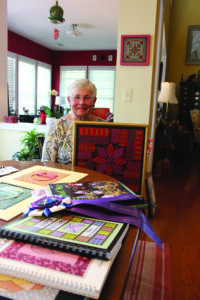
Over the last 40 years, Ann Strite-Kurz has created numerous embroidery pieces, written books on the subject and taught others the art form. (Photo by Sean Clougherty)
Ann Strite-Kurz has a standard response for people who look at her extensive embroidery and needlework collection and ask how she has the patience to make each stitch by hand.
Borrowing a friend’s response, she tells them, “You only have to have patience for things you don’t like to do.”
For more than 40 years, Strite-Kurz, of Easton, has found relaxation, friendship and even adventure through travel with embroidery, along with producing remarkable pieces that adorn her home and those of many friends and loved ones.
“It would be hard to rank what I find most satisfying but I would say the opportunity to be with other creative people who share the interest and passion for both stitching and other types of arts and crafts, the travel benefits of teaching in almost every U.S. state and in parts of Canada, and the fact that my career has stretched me in a way that I never anticipated,” she said.
Strite-Kurz started her embroidery journey in her 30s, just as it was entering a revival with the advent of new materials, wider availability of learning opportunities and celebrity stitchers who popularized the art form.
Now, while not really ever out-of-fashion, hand embroidery is riding another wave in popularity.
Strite-Kurz said she was attracted to the mathematical aspects of needlepoint and the opportunity to design innovative patterns that combine a variety of techniques. She found great joy in learning the many different stitches — more than 300 divided into nine general “families” that create the texture, shape and beauty in canvas embroidery. “I don’t call it a craft anymore,” she said. “To me, it’s an art form.”
She credits her mother’s eye for color as an aid as well and living in New England at the time, which surrounded her with teachers and learning opportunities. She took full advantage, taking classes in many different types of embroidery for more than a decade and then teaching for many more years.
“Those teachers were my mentors,” she said.
Though well-versed in the art form’s many nuances, she said her embroidery has gravitated to an open pattern concept, which leaves some canvas showing, especially in the background areas. She has authored six books and several pamphlets on different aspects of embroidery.
Strite-Kurz often used other non-embroidered artwork as inspiration and received permission from notable sources like wildlife artist Charley Harper to interpret their work in embroidery. She grew up on a farm and often chooses animals and birds as favorite subjects as well as geometric designs. “My theory is if you start with a good line drawing, it’s hard to mess it up,” she said.
Hand embroidery saw immense growth after World War II when a period of prosperity gave women more leisure time and money for hobbies. Beginning in the 1950s through the 1980s, notable stitchers like Erica Wilson and Elsa Williams took on a kind of celebrity status among embroiderers. “A renewed interest blossomed” Strite-Kurz said of that period. “I call it a renaissance.”
A graduate of the Royal School of Needlework in London, Wilson began teaching in the United States in 1954. Eventually she owned four retail needlework stores and had a summer school in Nantucket. She also wrote a syndicated column and her PBS Television Program “Erica” was filmed in Boston in ’71-’72 and again in ’75-’76. Because her studio was next to Julia Child’s, she became known as the “Julia Child of Needlework.” Strite-Kurz said of Wilson “That spread the word. She basically put embroidery on the map.”
Williams was “home grown” — born to missionary parents in South Dakota who encouraged her to stitch at an early age. She cultivated her talent for design in art school. Her studies, further developed by a subsequent career as an art director for a publishing company, lead to the founding of Needlecraft House in 1950. Her popular “heritage embroidery” kits were crewelwork, her favorite technique. She also had a syndicated column, and her Homer House School and Silver Thimble Exhibitions were well supported. In June 1972, she was recognized at the White House as one of America’s leading needlework designers, and was chosen by Julie Eisenhower to design and stitch a piece of crewelwork for the White House.
Also in this time period, the network of embroidery guilds was established. In 1959, the Embroiderer’s Guild of America (EGA) incorporated in New York and now boasts dozens of chapters divided among 12 U.S. regions. In Maryland, the Constellation Chapter meets at the Howard County Center for the Arts in Ellicott City and the Brandywine Chapter in Delaware meets at County House in Wilmington.
The American Needlepoint Guild was incorporated in 1972 and “encourages the practice and appreciation of needlepoint as an art form.”
It sponsors exhibits, workshops, meetings, conventions and tours to provide information and to stimulate the exchange of ideas and inspirations among members. ANG has chapters in 39 states, including Delaware’s Seashore Chapter, based in Reboboth. Both organizations have active community outreach programs for local and national causes and both guilds welcome beginners with no prior experience.
Through her involvement with the guilds, teaching and traveling, Strite-Kurz said she’s met people from diverse backgrounds who share the love of needlework. Many a flight attendant has interrupted Strite-Kurz’s in-flight embroidery to learn what stitches she’s using. She’s worked with a lot of health care professionals who find relaxation in the art form as well as a therapeutic way to keep their skilled hands limber and strong.
As interest grew in the’70 and ‘80s, new materials became available, including colored canvas as well as synthetic novelty threads and hand-dyed silks and cottons. “It just became popular to have something fun to work with other than wool,” she said. But wool, as well as the practice of covering the whole canvas is still a vital part of embroidery, she added, “The traditional technique using the Diagonal Basketweave or Tent stitch is still preferred for church kneelers, pillows, chair seats and any functional items that require good wearability.”
The digital revolution has had its own impact on the art form. There are fewer brick and mortar stores around as mail-order and online marketplaces have expanded.
Guilds are using technology to share centuries-old styles of embroidery. EGA offers an online studio, virtual education courses and a virtual lecture series to coincide with its more traditional correspondence course offerings.
“They’re trying very hard to get the chapters to get young people involved,” she said. “Compared to a decade ago, the response is very encouraging.” With YouTube videos plus Zoom classes and lectures galore, knowledge is more accessible than ever, but Strite-Kurz cautions, “always choose quality materials and learn from experts to create lasting treasures — your biggest investment is always your precious time!” Stores that remain, like Denise’s Needlework in St. Michaels and Salty Yarns in Berlin, offer regional instructional opportunities and guidance for beginners through advanced stitchers.
When Strite-Kurz dives into a piece, she said she often becomes a “binge stitcher,” putting in multiple hours daily between chores and exercise, but she also recognizes the importance of taking breaks. “You do get cross-eyed,” she said with a laugh.
But it’s not too long before she picks the needle and thread back up again.




